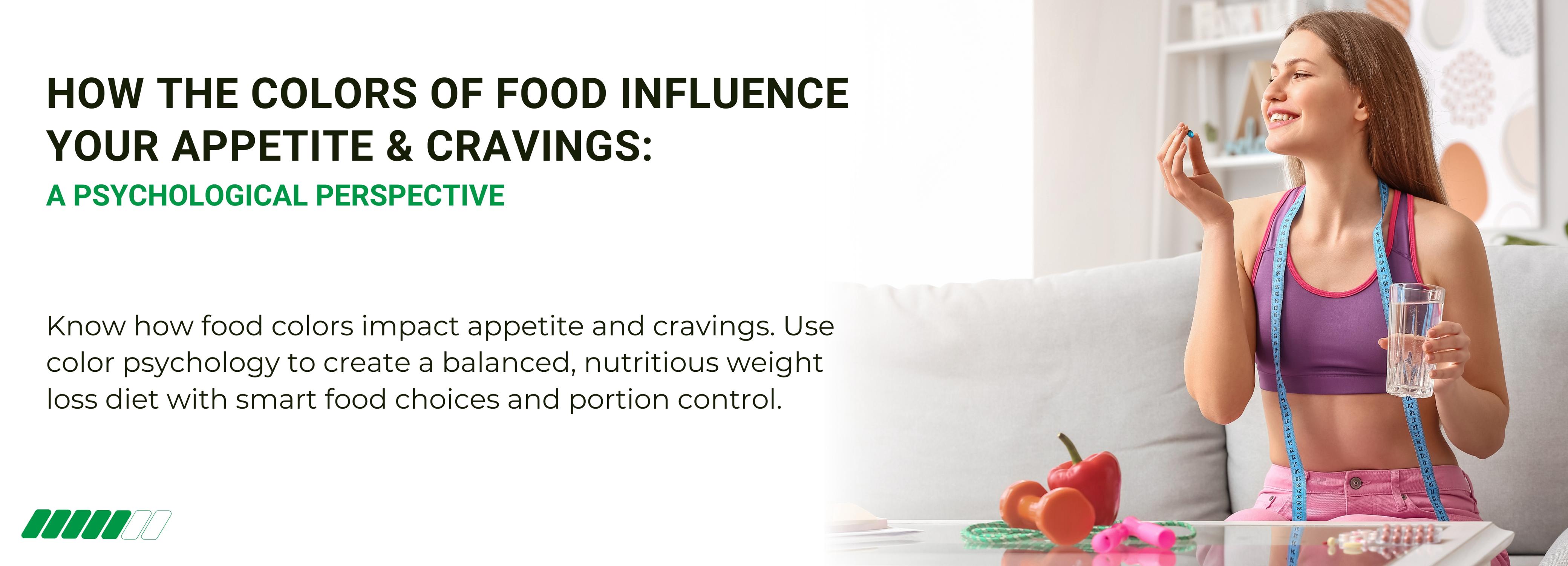
How the Colors of Food Influence Your Appetite and Cravings: A Psychological Perspective
Ever wonder why some foods appear more enticing than others? How come a bright red apple looks more appetizing than a boring brown one? A significant influence on our hunger, cravings, and even dietary decisions is the psychology of food colors. Colors arouse feelings and affect how we perceive flavor and contentment. This knowledge can be helpful when creating an Indian diet plan for weight loss that encourages good eating habits or while adhering to a weight loss diet plan chart. This blog post will discuss how different food colors impact appetite and cravings, and how you can use this information to develop a vegetarian diet plan for weight loss that supports your weight loss goals.
The Psychology of Food Colors
Human psychology is greatly impacted by colors, which can affect our feelings, actions, and even our eating patterns. According to studies, different hues elicit distinct tastes and appetites. The following describes how different food colors affect your appetite and weight loss process:
1. Red: Stimulates Appetite
A strong color that raises the heart rate enhances appetite, and instills a sense of urgency is red. For this reason, a lot of fast-food companies employ red in their interiors and branding. Because of their inherent beauty, red foods like tomatoes, red bell peppers, and strawberries can be included in a diet plan for weight loss for a visually pleasing and healthful dinner.
● Weight Loss Tip: Although red foods can increase hunger, choose fruits and vegetables that are naturally red rather than processed foods that have been artificially colored red.
2. Yellow and Orange: Encourages Cheerfulness and Hunger
Due to their associations with warmth and happiness, yellow and orange make enticing food colors. They can increase the amount of food consumed and improve the impression of sweetness. Yellow and orange foods that occur naturally include sweet potatoes, carrots, mangoes, and pumpkins.
● Weight Loss Tip: To make your meals enticing without going overboard, use these colors sparingly while creating your weight loss diet chart.
3. Green: Symbolizes Health and Freshness
Beverages often come loaded with sugar and empty calories. Healthy substitutes can keep you hydrated and satisfied:
Green is often linked with health, nature, and freshness. It creates a sense of balance and encourages healthier eating habits. Leafy greens, cucumbers, avocados, and green apples are excellent choices for a vegetarian diet plan for weight loss .
● Weight Loss Tip: Fill half your plate with green foods to promote satiety and add nutrient density to your meals.
4. Blue and Purple: Suppresses Appetite
Blue is among the least appetizing colors, as it rarely occurs naturally in food. It is believed to suppress appetite and reduce cravings. Purple foods like eggplants, blueberries, and purple cabbage, however, contain antioxidants beneficial for weight loss.
● Weight Loss Tip: If you are trying to control portions, using blue plates or table settings may help reduce overeating.
5. White and Beige: Perceived as Bland but Filling
White and beige foods, such as rice, potatoes, bread, and pasta, often lack vibrant colors but provide comfort and satiety. Unfortunately, they are also associated with high-calorie intake and weight gain if consumed in excess.
● Weight Loss Tip: Opt for whole grains and fiber-rich versions of white foods to support your weight loss diet plan chart.
6. Brown: Comforting but Dense in Calories
Brown foods, such as chocolates, nuts, and whole grains, are perceived as rich and indulgent. While they can be nutrient-dense, they also tend to be high in calories.
● Weight Loss Tip: Choose whole, unprocessed brown foods like whole wheat, quinoa, and almonds in moderation to maintain balance in your diet plan for weight loss.
7. Black: Unusual but Trendy
Black foods, such as black beans, black rice, and activated charcoal products, have gained popularity for their health benefits. They provide a sense of sophistication and novelty in a meal while being packed with nutrients.
● Weight Loss Tip: Incorporate black foods occasionally for variety, but ensure they align with your diet chart for weight loss.
Using Color Psychology to Optimize Your Weight Loss Diet
Now that we understand how colors affect our appetite, let’s explore practical ways to use color psychology to support a weight loss diet:
1. Plate Your Food Strategically
- Use blue plates to reduce hunger and prevent overeating.
- Add vibrant colors like green, red, and yellow for an appetizing but healthy meal.
- Avoid monochrome meals, which can seem unappealing and lead to cravings for unhealthy snacks.
2. Choose Colorful, Nutrient-Dense Foods
A diverse range of colors on your plate ensures a variety of essential nutrients. Aim for a rainbow diet:
- Red: Tomatoes, strawberries, watermelon
- Orange & Yellow: Carrots, mangoes, sweet potatoes
- Green: Spinach, broccoli, avocado
- Blue & Purple: Blueberries, eggplant, grapes
- Brown: Whole grains, nuts, lentils
3. Control Portion Sizes with Color
- Lighter-colored foods (like white rice) should be consumed in controlled portions.
- Darker foods (like leafy greens) can be eaten in larger quantities.
4. Be Mindful of Artificial Coloring
Processed foods often contain artificial colors that trigger cravings without providing real nutritional benefits. Stick to naturally colored foods to support your Indian diet plan for weight loss.
A Sample Color-Based Vegetarian Diet Plan for Weight Loss
Here is a simple, color-balanced weight loss diet plan:
Breakfast
- A smoothie with blueberries (blue), banana (yellow), and spinach (green)
- Whole wheat toast (brown) with peanut butter
Mid-Morning Snack
- A handful of almonds (brown) and green tea
Lunch
- Mixed vegetable salad with red bell peppers, cucumbers, and carrots (red, green, orange)
- Brown rice with dal (brown, yellow)
Evening Snack
- Roasted chickpeas (brown) and a fruit smoothie with mango (yellow) and coconut water Dinner
- Stir-fried vegetables (green, red, yellow)
- Quinoa or whole wheat chapati (brown)
- Greek yogurt with berries (blue, purple)
Conclusion
The colors of food influence appetite, cravings, and even portion control. By understanding color psychology, you can create a diet plan for weight loss that is not only visually appealing but also nutritious and effective. Incorporating a wide variety of colorful, nutrient-rich foods into your weight loss diet chart can make your meals more satisfying while supporting your health goals. Whether you follow an Indian diet plan for weight loss or a vegetarian diet plan for weight loss, using food colors wisely can be a powerful tool in your journey to a healthier lifestyle.
